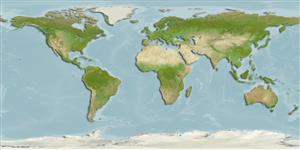Environment: milieu / climate zone / depth range / distribution range
पारिस्थितिकी
समुद्री बाथीड़िमरसल; गहराई सीमा 247 - 460 m. Deep-water; 70°S - 74°S
Southern Ocean: Weddell Sea and East Antarctica (Prydz Bay).
आकार / वज़न / Age
Maturity: Lm ? range ? - ? cm
Max length : 26.0 cm TL पुल्लिंग / अलिंग; (Ref. 5181)
The only species of the genus with conspicuous ventral spots. Adults maybe nesters due to low absolute fecundity (Ref. 52020).
Low absolute fecundity of this species may indicate nesting behavior.
Eakin, R.R., 1990. Artedidraconidae. p. 332-356. In O. Gon and P.C. Heemstra (eds.) Fishes of the Southern Ocean. J.L.B. Smith Institute of Ichthyology, Grahamstown, South Africa. (Ref. 5181)
IUCN Red List Status (Ref. 130435: Version 2024-2)
Threat to humans
Harmless
Human uses
मात्स्यिकी: कोई रुचि बग़ैर
साधन
Special reports
Download XML
इंटरनेट स्रोत
Estimates based on models
Preferred temperature (Ref.
123201): -1.7 - -0.8, mean -1.2 °C (based on 8 cells).
Phylogenetic diversity index (Ref.
82804): PD
50 = 0.5000 [Uniqueness, from 0.5 = low to 2.0 = high].
Bayesian length-weight: a=0.00501 (0.00240 - 0.01046), b=3.13 (2.94 - 3.32), in cm total length, based on LWR estimates for this (Sub)family-body shape (Ref.
93245).
Trophic level (Ref.
69278): 3.3 ±0.5 se; based on size and trophs of closest relatives
लौटाव (Ref.
120179): माध्यम, न्यूनतम जनसंख्या दुगनी होने का समय 1.4 - 4.4 वर्ष। (Fec = 980).
Fishing Vulnerability (Ref.
59153): Low vulnerability (16 of 100).
